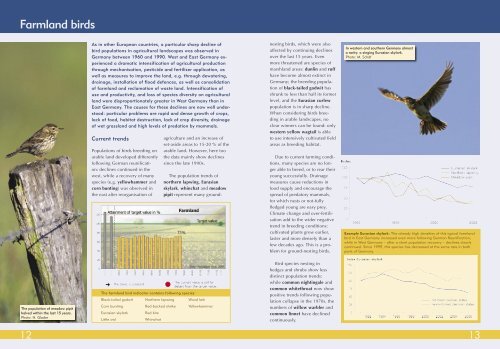Birds and Biodiversity in Germany - Bundesamt für Naturschutz
Birds and Biodiversity in Germany - Bundesamt für Naturschutz
Birds and Biodiversity in Germany - Bundesamt für Naturschutz
Create successful ePaper yourself
Turn your PDF publications into a flip-book with our unique Google optimized e-Paper software.
Farml<strong>and</strong> birds<br />
The population of meadow pipit<br />
halved with<strong>in</strong> the last 15 years.<br />
Photo: H. Glader<br />
As <strong>in</strong> other European countries, a particular sharp decl<strong>in</strong>e of<br />
bird populations <strong>in</strong> agricultural l<strong>and</strong>scapes was observed <strong>in</strong><br />
<strong>Germany</strong> between 1960 <strong>and</strong> 1990. West <strong>and</strong> East <strong>Germany</strong> experienced<br />
a dramatic <strong>in</strong>tensification of agricultural production<br />
through mechanisation, pesticide <strong>and</strong> fertiliser application, as<br />
well as measures to improve the l<strong>and</strong>, e.g. through dewater<strong>in</strong>g,<br />
dra<strong>in</strong>age, <strong>in</strong>stallation of flood defences, as well as consolidation<br />
of farml<strong>and</strong> <strong>and</strong> reclamation of waste l<strong>and</strong>. Intensification of<br />
use <strong>and</strong> productivity, <strong>and</strong> loss of species diversity on agricultural<br />
l<strong>and</strong> were disproportionately greater <strong>in</strong> West <strong>Germany</strong> than <strong>in</strong><br />
East <strong>Germany</strong>. The causes for these decl<strong>in</strong>es are now well understood:<br />
particular problems are rapid <strong>and</strong> dense growth of crops,<br />
lack of food, habitat destruction, lack of crop diversity, dra<strong>in</strong>age<br />
of wet grassl<strong>and</strong> <strong>and</strong> high levels of predation by mammals.<br />
Current trends<br />
Populations of birds breed<strong>in</strong>g on<br />
arable l<strong>and</strong> developed differently<br />
follow<strong>in</strong>g German reunification:<br />
decl<strong>in</strong>es cont<strong>in</strong>ued <strong>in</strong> the<br />
west, while a recovery of many<br />
species (e.g. yellowhammer <strong>and</strong><br />
corn bunt<strong>in</strong>g) was observed <strong>in</strong><br />
the east after reorganisation of<br />
agriculture <strong>and</strong> an <strong>in</strong>crease of<br />
set-aside areas to 15-20 % of the<br />
arable l<strong>and</strong>. However, here too<br />
the data ma<strong>in</strong>ly show decl<strong>in</strong>es<br />
s<strong>in</strong>ce the late 1990s.<br />
The population trends of<br />
northern lapw<strong>in</strong>g, Eurasian<br />
skylark, wh<strong>in</strong>chat <strong>and</strong> meadow<br />
pipit represent many ground-<br />
The farml<strong>and</strong> bird <strong>in</strong>dicator conta<strong>in</strong>s follow<strong>in</strong>g species:<br />
Black-tailed godwit Northern lapw<strong>in</strong>g Wood lark<br />
Corn bunt<strong>in</strong>g Red-backed shrike Yellowhammer<br />
Eurasian skylark Red kite<br />
Little owl Wh<strong>in</strong>chat<br />
nest<strong>in</strong>g birds, which were also<br />
affected by cont<strong>in</strong>u<strong>in</strong>g decl<strong>in</strong>es<br />
over the last 15 years. Even<br />
more threatened are species of<br />
marshl<strong>and</strong> areas: dunl<strong>in</strong> <strong>and</strong> ruff<br />
have become almost ext<strong>in</strong>ct <strong>in</strong><br />
<strong>Germany</strong>; the breed<strong>in</strong>g population<br />
of black-tailed godwit has<br />
shrunk to less than half its former<br />
level, <strong>and</strong> the Eurasian curlew<br />
population is <strong>in</strong> sharp decl<strong>in</strong>e.<br />
When consider<strong>in</strong>g birds breed<strong>in</strong>g<br />
<strong>in</strong> arable l<strong>and</strong>scapes, no<br />
clear w<strong>in</strong>ners can be found: only<br />
western yellow wagtail is able<br />
to use <strong>in</strong>tensively cultivated field<br />
areas as breed<strong>in</strong>g habitat.<br />
Due to current farm<strong>in</strong>g conditions,<br />
many species are no longer<br />
able to breed, or to rear their<br />
young successfully. Dra<strong>in</strong>age<br />
measures cause reductions <strong>in</strong><br />
food supply <strong>and</strong> encourage the<br />
spread of predatory mammals,<br />
for which nests or not-fully<br />
fledged young are easy prey.<br />
Climate change <strong>and</strong> over-fertilisation<br />
add to the wider negative<br />
trend <strong>in</strong> breed<strong>in</strong>g conditions:<br />
cultivated plants grow earlier,<br />
faster <strong>and</strong> more densely than a<br />
few decades ago. This is a problem<br />
for ground-nest<strong>in</strong>g birds.<br />
Bird species nest<strong>in</strong>g <strong>in</strong><br />
hedges <strong>and</strong> shrubs show less<br />
dist<strong>in</strong>ct population trends:<br />
while common night<strong>in</strong>gale <strong>and</strong><br />
common whitethroat now show<br />
positive trends follow<strong>in</strong>g population<br />
collapse <strong>in</strong> the 1970s, the<br />
numbers of willow warbler <strong>and</strong><br />
common l<strong>in</strong>net have decl<strong>in</strong>ed<br />
cont<strong>in</strong>uously.<br />
In western <strong>and</strong> southern <strong>Germany</strong> almost<br />
a rarity: a s<strong>in</strong>g<strong>in</strong>g Eurasian skylark.<br />
Photo: M. Schäf<br />
Example Eurasian skylark: The already high densities of this typical farml<strong>and</strong><br />
bird <strong>in</strong> East <strong>Germany</strong> <strong>in</strong>creased even more follow<strong>in</strong>g German Reunification,<br />
while <strong>in</strong> West <strong>Germany</strong> – after a short population recovery – decl<strong>in</strong>es clearly<br />
cont<strong>in</strong>ued. S<strong>in</strong>ce 1999, this species has decreased at the same rate <strong>in</strong> both<br />
parts of <strong>Germany</strong>.<br />
12 13

















